ORIF - Lag screw with neutralization plate
1. General considerations
Treatment principle
Due to the length and location of the fracture in relation to the diameter of the distal humerus and the strong rotational forces addition of a neutralization plate is mandatory.
The neutralization plate is typically placed on the same side as the lag screw. This preserves the soft-tissue envelope on the other side of the distal humerus.
The plate is applied on the side with more distal bone available for fixation.
The lag screw may be placed independently or through the plate, depending on the fracture configuration and the chosen plate.
With a lateral or medial plate, the lag screw would be placed through the plate. With a dorsolateral plate, an independent lag screw is placed.
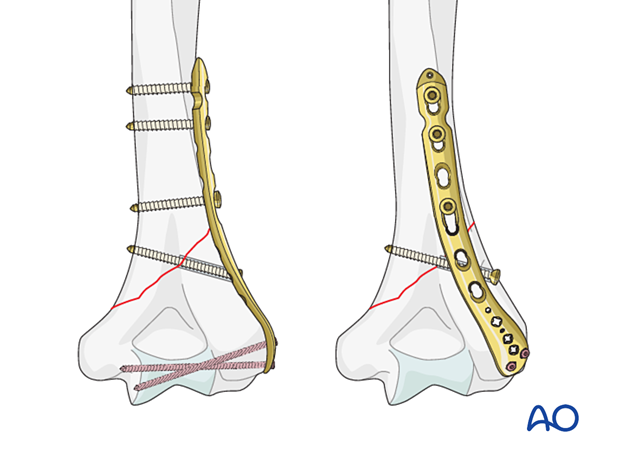
This construct is only possible if there is sufficient bone proximal to the olecranon fossa to apply a lag screw.
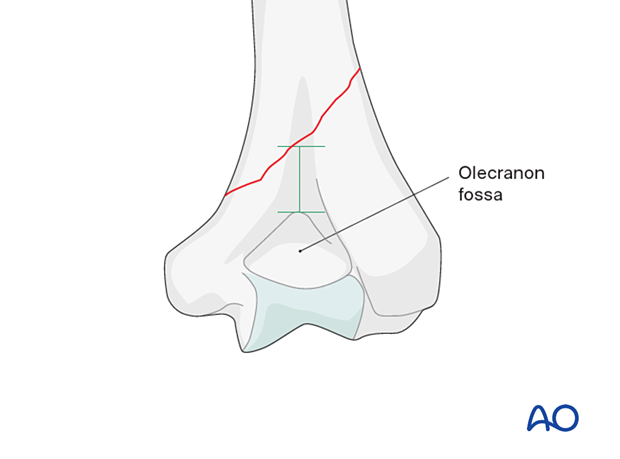
In the following, the treatment of an obliquely distal and medial fracture is described. The obliquely distal and lateral fracture is treated analogously.
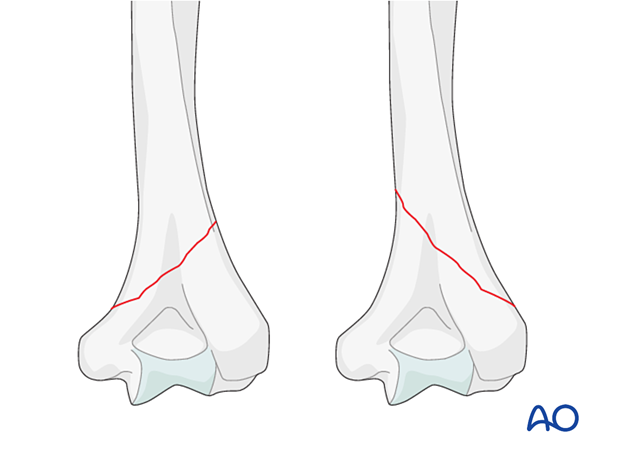
Triangle-of-stability concept
The mechanical properties of the distal humerus are based on a triangle of stability, comprising the medial and lateral columns and the articular block (see also the anatomical concepts).

Plate position
The plate can be applied either directly laterally, or dorsolaterally to support a primary lag screw.
This procedure illustrates the direct lateral plate application as the primary option. The application of a dorsolateral plate is the alternative option.

Screw selection
The screws that cross the fracture site should normally only have thread purchase in the far fragment to apply interfragmentary compression.
In the shaft, 2.7 and 3.5 mm screws are most commonly used.
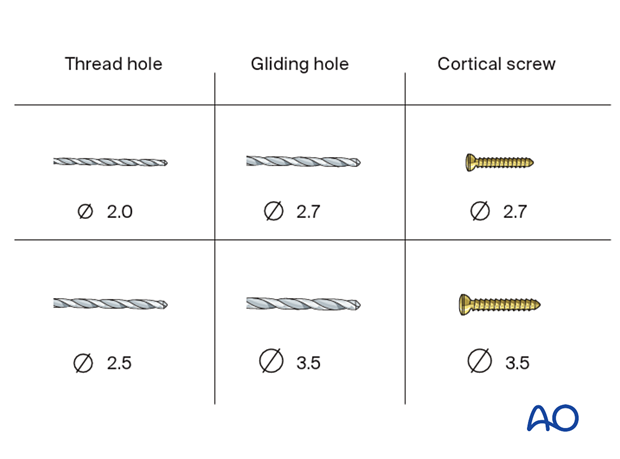
The articular screws are 2.7 mm metaphyseal and VA-LCP locking screws.
Note: radial nerve at risk
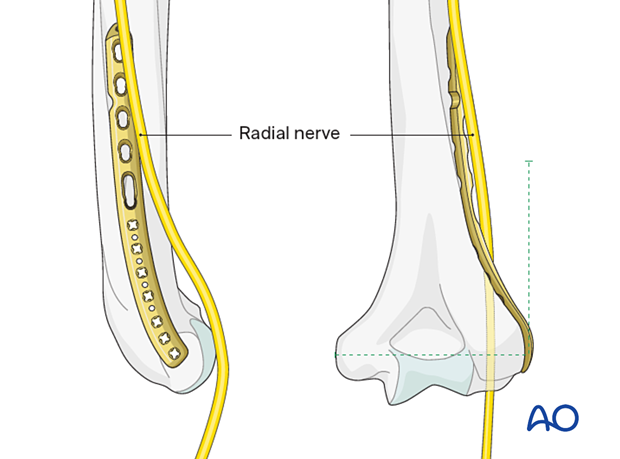
Note: ulnar nerve at risk
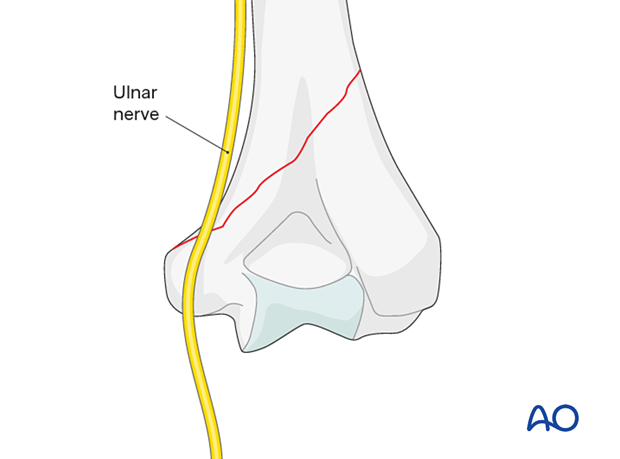
2. Patient preparation and approaches
Patient positioning
This procedure is usually performed with the patient either in a prone position or lateral decubitus position.
Approaches
For this fracture pattern, either a triceps-split or paratricipital approach may be used.
If only a lateral plate is to be used, a triceps-on approach is preferred.
If both columns are to be fixed, a triceps-split approach may be preferred.
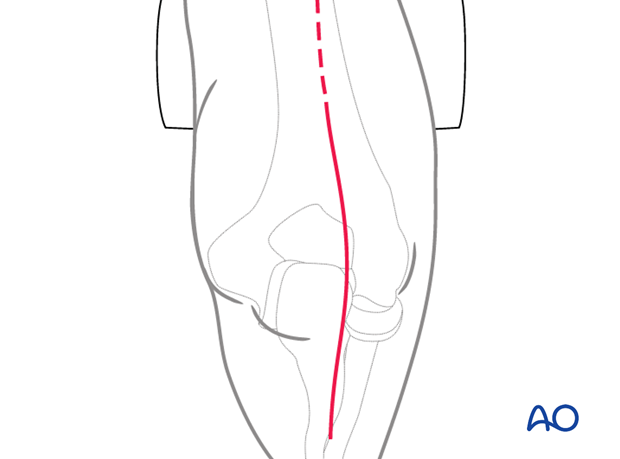
3. Reduction and temporary fixation
Reduce the main fragments anatomically and maintain reduction with forceps.
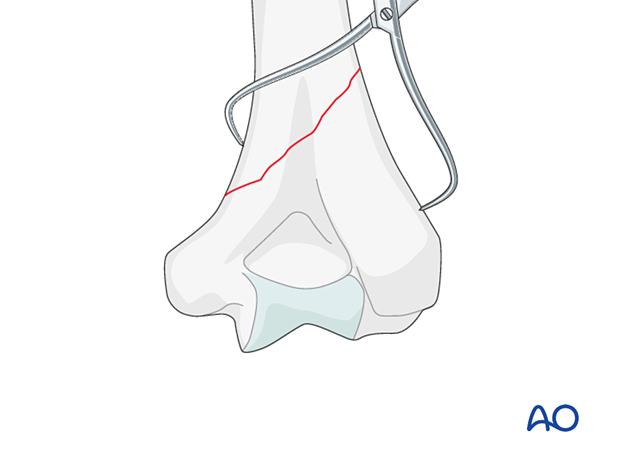
Preliminary fixation with axial K-wires may be helpful. To avoid risk to the ulnar nerve, K-wires from laterally may be preferred.
If necessary, check the reduction and provisional fixation with image intensification.
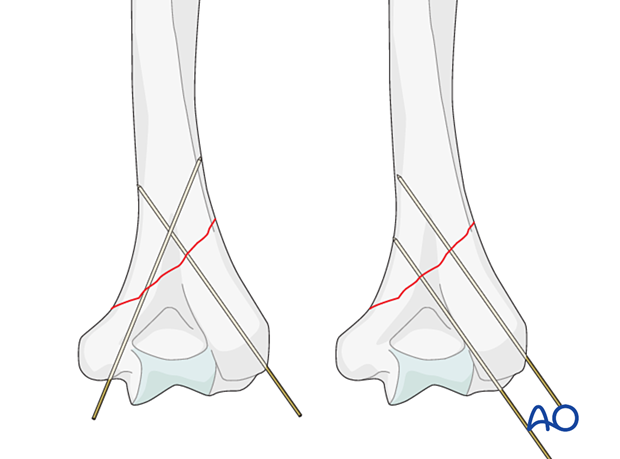
4. Planning for plate and screw position
If the fracture pattern and bone quality permit a lag screw, it is now important to choose the position of the plate and screw.
With a lateral or medial plate, the lag screw is inserted through the plate.
With a dorsolateral plate, an independent lag screw is usually placed.
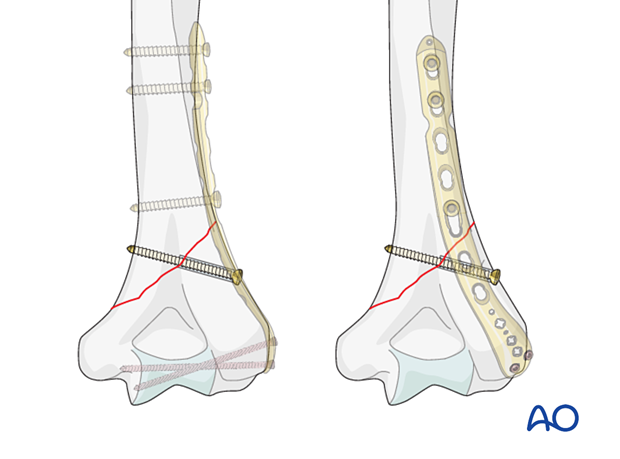
5. Plate application
Basic techniques
The basic technique for application of anatomical plates is described in:
If precontoured anatomical plates are not available, see the basic technique for application of reconstruction plates.
6. Lag screw outside plate
Lag screw insertion
If the lag screw is planned outside the plate, insert the screw before the plate in a standard manner.
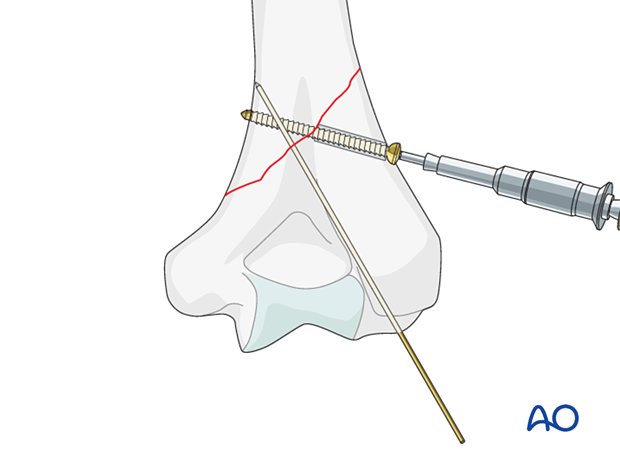
Dorsolateral plate application
For a dorsolateral plate, place the lag screw independent of the plate in a standard manner.
The dorsolateral plate is then placed in a neutralization mode.
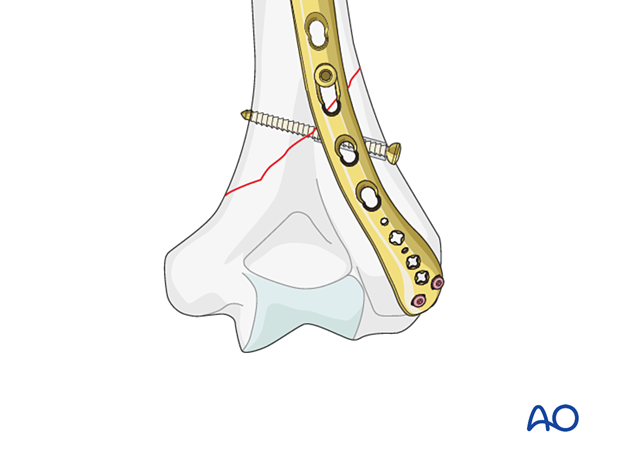
7. Lag screw through the plate
Lateral plate application
Apply a lateral plate to the bone and stabilize it temporarily with K-wires or forceps.
Insert a proximal cortical screw in the combihole, then insert the distal screws.
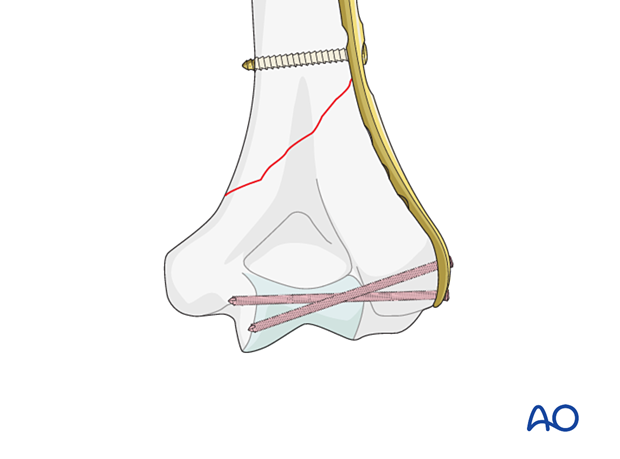
Lag screw insertion
Apply the lag screw through the plate from distal to proximal. Before final tightening, loosen the proximal screw.
Add further screws to finalize the construct.
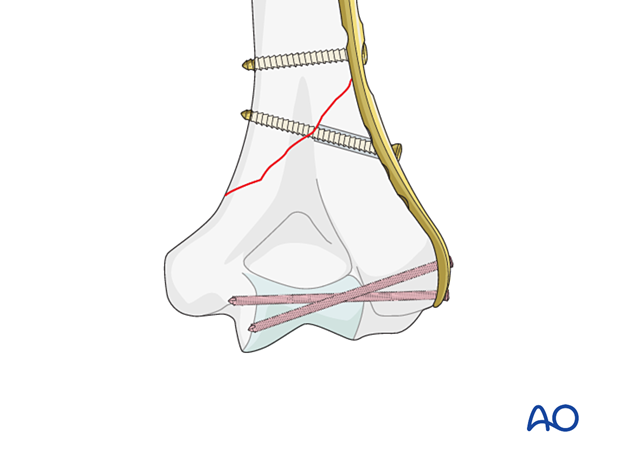
Medial plate application
In an obliquely distal and lateral fracture, the lag screw and plate will be placed from the medial side.
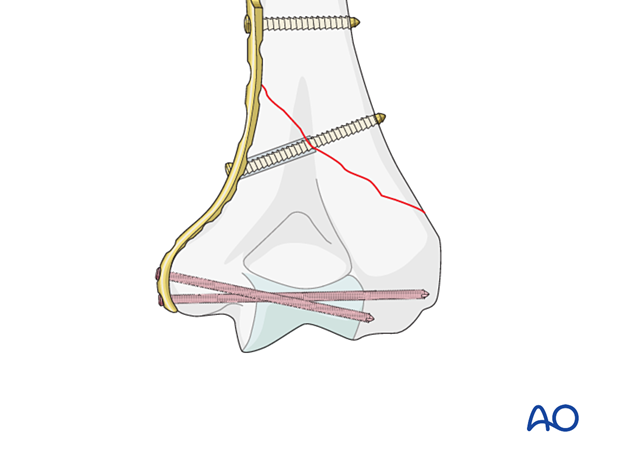
8. Final assessment
Visually inspect the fixation and manually check for fracture stability.
Repeat the manual check under image intensification.
9. Aftercare
Introduction
The rehabilitation protocol consists usually of three phases:
- Rehabilitation until wound healing
- Rehabilitation until bone healing
- Functional rehabilitation after bone healing
Immediate aftercare
The arm is bandaged to support and protect the surgical wound.
The arm is rested on pillows in slight flexion of the elbow so that the hand is positioned above the level of the heart.
Short-term splinting may be applied for soft-tissue support.
Neurovascular observations are made frequently.
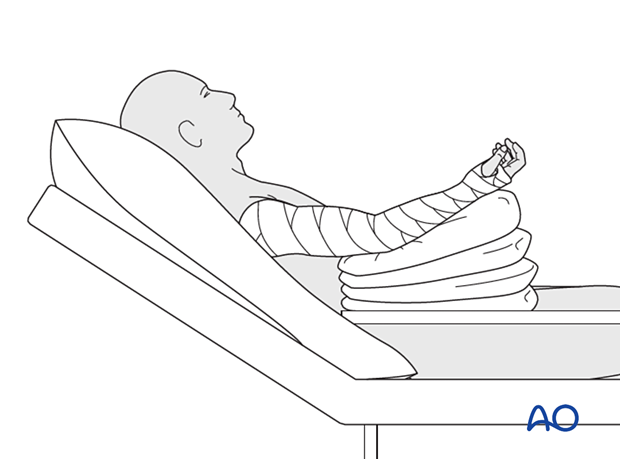
Hand pumping and forearm rotation exercises are started as soon as possible to reduce lymphedema and to improve venous return in the limb. This helps to reduce postoperative swelling.
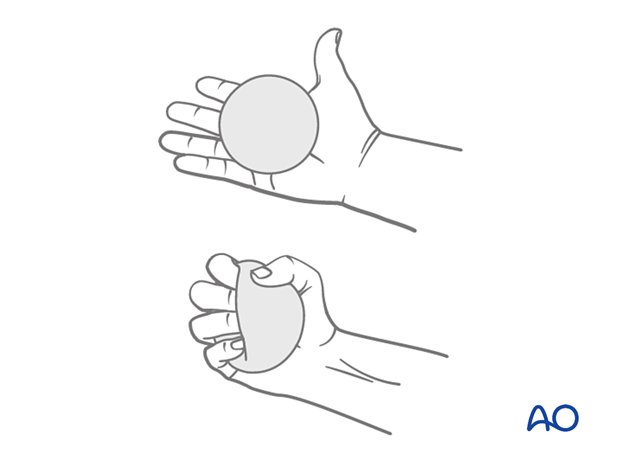
Mobilization until wound healing
Gravity-eliminated active assisted exercises of the elbow should be initiated as soon as possible, as the elbow is prone to stiffness:
- The bandages are removed, and the arm rested on a side table
- Flexion/extension of the arm at the elbow is encouraged in a gentle sweeping movement on the tabletop as far as comfort permits (as illustrated)
- Full pronation and supination in protected arm position is encouraged
- Exercises are performed hourly in repetitions, the number of which is governed by comfort
- Between periods of exercise, the elbow is rested in the elevated position for at least the first 48 hours postoperatively
- Keep the arm elevated between periods of exercise until the wound has healed
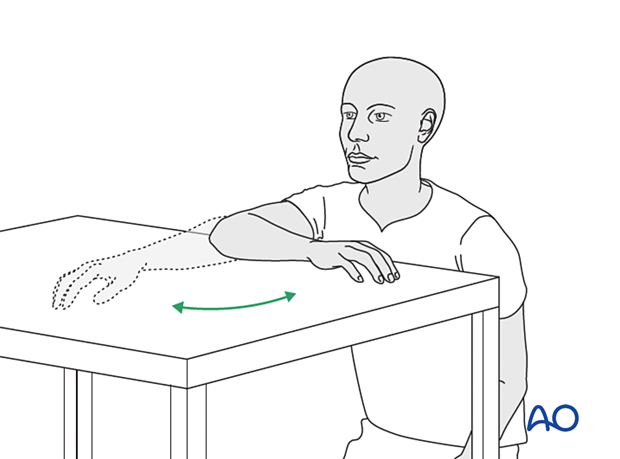
Rehabilitation until bone healing
Active patient-directed range-of -motion exercises should be encouraged without the routine use of splintage or immobilization.
Avoid forceful motion, repetitive loading, or weight-bearing through the arm.
A simple compressive sleeve can provide proprioceptive feedback which can help regain motion and avoid cocontraction.
No load-bearing (ie, pushing, pulling, or carrying weights) or strengthening exercises are allowed until early fracture healing is established by x-ray and clinical examination.
This is usually a minimum of 8–12 weeks after injury. Weight-bearing on the arm should be avoided until bony union is assured.
The patient should avoid resisted extension activities, especially after a triceps-elevating approach or olecranon osteotomy.
Rehabilitation after bone healing
When the fracture has united, a combination of active functional motion and kinetic chain rehabilitation can be initiated.
Active assisted elbow motion exercises are continued. The patient bends the elbow as much as possible using his/her muscles while simultaneously using the opposite arm to gently push the arm into further flexion. This effort should be sustained for several minutes; the longer, the better.
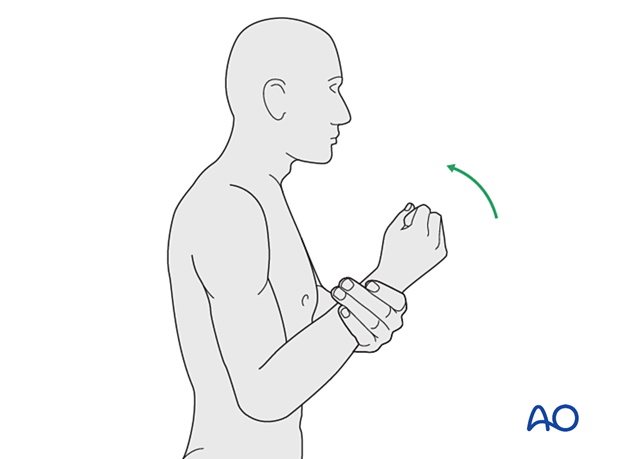
Next, a similar exercise is performed for extension.

If the patient finds it difficult to accomplish these exercises when seated, then performing the same exercises when lying supine can be helpful.
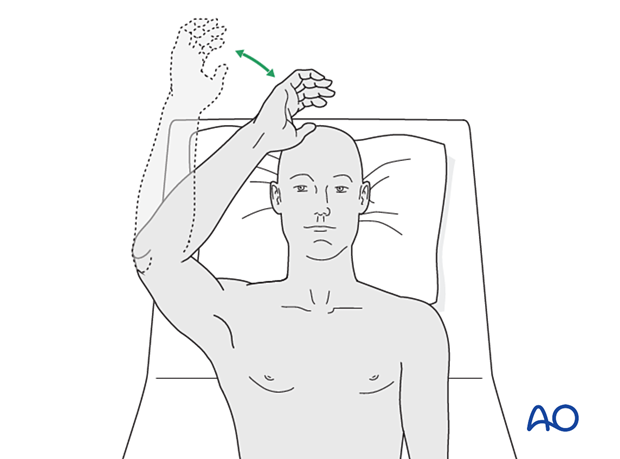
Implant removal
Generally, the implants are not removed. If symptomatic, hardware removal may be considered after consolidated bony healing, usually no less than 6 months for metaphyseal fractures and 12 months when the diaphysis is involved. The avoidance of the risk of refracture requires activity limitation for some months after implant removal.













